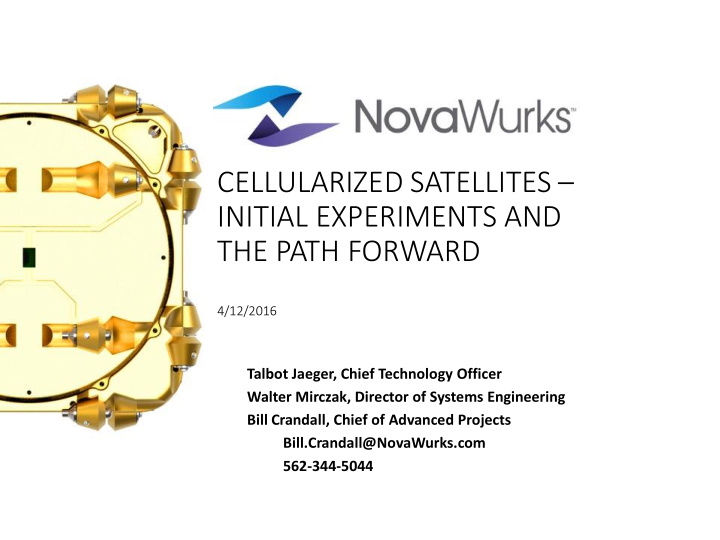



CELLULARIZED SATELLITES – INITIAL EXPERIMENTS AND THE PATH FORWARD 4/12/2016 Talbot Jaeger, Chief Technology Officer Walter Mirczak, Director of Systems Engineering Bill Crandall, Chief of Advanced Projects Bill.Crandall@NovaWurks.com 562-344-5044
HISats as the Basic Building Blocks • NovaWurks has successfully developed HISat prototypes for the DARPA Phoenix Satlet program • Using a biological cell approach to the development of satlets yielded the HISat (Hyper-Integrated Satlet), a stem-cell-like, software defined system cell • HISat is an architecture component into which all the functional capabilities of a spacecraft are provided at a unit hardware level, differentiated upon demand, and aggregated by software • Can be aggregated together to serially increase performance with increased numbers of HISats • By reassembling a sufficient amount of HISats and payloads, a spacecraft with the required capabilities can be formed by aggregation of resources 4/12/2016 2
The Cellular Satellite • Spacecraft from 75kg to over 3,000kg have been designed • Payloads are added using a User Defined Adapter (UDA) • Programmable ‘space ready’ support system allows for flexible and rapid integration • Provides for power, data, and thermal management • Flexibility – Configures to meet Payload needs, late life cycle changes can be accommodated • Resiliency – Disaggregated shared resources allow multiple redundancy and graceful degradation • No SWAP penalty – Redundancy by design, not duplication of units • Lower Cost – Mass produced cells 4/12/2016 3
Mass Production Advantages • Lower cost to produce building blocks • Repeatability in kitting, assembly, and testing • Lower tooling costs • Identical testing across all units • Potential for Robotic handling • Low cost engineering model availability • One HISat is like having a copy of your satellite on the ground Production Line Mass production Facility 4/12/2016 4
What about CubeSats? • Cubesats are form factor limiting • What if your payload doesn’t fit in 1U, 3U, or even 27U? • Cubesats overlook the substantial cost to improve • Performance • Minimum is the NRE to adapt existing or create new technologies (versus HISats that adapt to both) • Lifetime • Underestimate true cost of redundancy or constant replacement Lessons Derived From CubeSats Direct application of typical 1-U or 3-U CubeSat technology is not the answer. Recent data presented by Tyvac at the Space Tech Expo in Long Beach, California, in 2015 cited more than 65 percent of CubeSats failed to adequately operate or failed their mission within six months on orbit. Another study by NASA Goddard in 2015 revealed that the median life of a 1 kg 1U CubeSat is estimated to be 85 days. In contrast, the median life of a 4 kg 3U CubeSat is only 22 days. ( Reference: CubeSat data analysis, NASA Goddard Code 371, November 2015 .) http://www.satmagazine.com/story.php?number=1291866316 4/12/2016 5
Where HISats are being used now • SIMPL was delivered to the Space Station in Dec 2015 • Pathfinder for reconfiguration and assembly in space • Astronauts will assemble HISats achieving a deployment-ready configuration • 8 individual modules delivered • First non-air propulsion system allowed inside the ISS • eXCITe will launch in July 2016 • To be Launched fully assembled on Falcon 9, deployed via SHERPA into near SSO • Carrying 5 payloads, with soft ride to orbit technology • Will jettison one payload to become a free flyer • Demonstrates ability to automatically adapt to changing CG • PODSat will launch in 1Q2017 • Testing space environments in GTO orbit • StarCell • Ground testing robotic self assembly techniques • Payload Test Bed – Testing out new payloads • PTB-1 will launch in early 2017 to ISS • PTB-2 will launch in late 2017 to SSO • Some rideshare space still available • Contact Bill.Crandall@NovaWurks.com 4/12/2016 6
The Path Forward • Future plans for on-orbit robotic assembly and reconfiguration • Supports “New Space” Missions • Enables Satellite servicing • Increased production rate • Opportunities are available now • Payload Test Bed Program opportunity for payloaders to try new technologies in space • Cost effective hosting of high performance traditional payloads with added flexibility and resiliency • Opportunities for early- stage designs for future “new space” capabilities • We can make your payload into a satellite, maybe even turn your science fiction dream into fact. 4/12/2016 7
Contact Info • On the Web: • www.NovaWurks.com • Any questions: • Bill Crandall, Chief of Advanced Projects • Bill.Crandall@NovaWurks.com • (562) 344-5044 • Toll free (844) 668-2987 ext. 2 4/12/2016 8
Recommend
More recommend